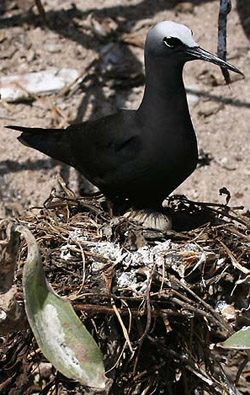Republic of Nauru

Birding Narau
Nauru, officially the Republic of Nauru, is an island nation in the Micronesian South Pacific. The nearest neighbour is Banaba Island in the Republic of Kiribati, 300 km due east. Nauru is the world’s smallest island nation, covering just 21 km² (8.1 sq. mi), the smallest independent republic, and the only republican state in the world without an official capital. It is the least populous member of the United Nations.Nauru is made up of a raised central plateau surrounded by a fertile coastal fringe. The plateau, known as ‘topside’, is the site of mining [of guano deposits]and is for the most part made up of limestone pinnacles, a truly unique landscape. In contrast, the coast has lush and verdant vegetation. Nauru is a small, oval-shaped island in the western Pacific Ocean, 42 km (26 mi.) south of the Equator. The island is surrounded by a coral reef, exposed at low tide and dotted with pinnacles. The reef is bound seaward by deep water, and inside by a sandy beach. The presence of the reef has prevented the establishment of a seaport, although sixteen artificial canals have been made in the reef to allow small boats to access the island. A 150–300 m (about 500–1000 ft.) wide fertile coastal strip lies landward from the beach. Coral cliffs surround the central plateau, which is known on the island as Topside. The highest point of the plateau called the Command Ridge is 71 m above sea level. The only fertile areas are the narrow coastal belt, where coconut palms flourish. The land surrounding Buada Lagoon supports bananas, pineapples; vegetable, pandanus trees and indigenous hardwoods such as the tomano tree are cultivated. The population of the island is concentrated in the coastal belt and around Buada Lagoon.The plateau area contains large phosphate deposits that almost completely inhibit any natural growth useful for subsistence or commerce. Large areas of scrub and creeper, with occasional coconut and tamanu trees, grow in this region. On the coastal belt, coconut palms and pandanus (a type of screw pine) thrive. Some hibiscus, frangipani, and other tropical flowers grow, but they do not abound here as on other Pacific islands. Bird life is not plentiful, although noddies, terns, and frigate birds frequent the island. There are no indigenous land animals; however, hogs and poultry were introduced many years ago. Fish life is abundant in the seas encircling Nauru and good catches of tuna and bonito are taken.
There are limited natural fresh water resources on Nauru. Roof storage tanks collect rainwater, but islanders are mostly dependent on a single, aging desalination plant. Nauru’s climate is hot and extremely humid year-round, because of the proximity of the land to the Equator and the ocean. The island is affected by monsoonal rains between November and February. Annual rainfall is highly variable and influenced by the El Niño-Southern Oscillation, with several recorded droughts.[21] The temperature ranges between 26 and 35 °C (79 and 95 °F) during the day and between 25 and 28 °C (77 and 82 °F) at night. As an island nation, Nauru may be vulnerable to climate and sea level change, but to what degree is difficult to predict; at least 80% of the land area of Nauru is well elevated, but this area will be uninhabitable until the phosphate mining rehabilitation program is implemented.
There are only sixty recorded vascular plant species native to the island, none of which are endemic. Coconut farming, mining and introduced species have caused serious disturbance to the native vegetation. There are no native land mammals; there are native birds, including the endemic Nauru Reed Warbler, insects and land crabs. The Polynesian Rat, cats, dogs, pigs and chickens have been introduced to the island.
With just 27 bird species recorded Narau is not at the top on many birder’s list of must see locations. However, there is the one endemic reed warbler as well as plenty of opportunities to see some stunning seabirds.
-
Wikipedia
GNU Free Documentation License
http://en.wikipedia.org/wiki/Nauru
-
Number of bird species: 27
Number of endemics: 1
Nauru Reed-warbler Acrocephalus rehsei
-
iGoTerra Checklist
iGoTerra ChecklistFatbirder Associate iGoTerra offers the most comprehensive and up to date birds lists on the web
-
BirdLife IBAs
WebsiteGeneral characteristics Nauru, an independent nation, is a raised limestone island (21 km2) in the west-central Pacific, and is a Secondary Area on the basis of its single-island endemic, Nauru Reed-warbler Acrocephalus rehsei -
List of birds of Nauru
WebsiteThis is a list of the bird species recorded in Nauru. The avifauna of Nauru includes a total of 27 species, of which 1 is endemic
